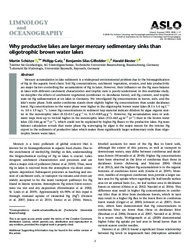Why productive lakes are larger mercury sedimentary sinks than oligotrophic brown water lakes
DOI: https://doi.org/10.1002/lno.11684
Persistent URL: http://resolver.sub.uni-goettingen.de/purl?gldocs-11858/8552
Persistent URL: http://resolver.sub.uni-goettingen.de/purl?gldocs-11858/8552
Schütze, Martin; Gatz, Philipp; Gilfedder, Benjamin‐Silas; Biester, Harald, 2020: Why productive lakes are larger mercury sedimentary sinks than oligotrophic brown water lakes. In: Limnology and Oceanography, DOI: 10.1002/lno.11684.
 |
Dokument öffnen: |
Mercury accumulation in lake sediments is a widespread environmental problem due to the biomagnification of Hg in the aquatic food chain. Soil Hg concentrations, catchment vegetation, erosion, and lake productivity are major factors controlling the accumulation of Hg in lakes. However, their influence on the Hg mass balance in lakes with different catchment characteristics and trophic state is poorly understood. In this multilake study, we decipher the effects of catchment vegetation (coniferous vs. deciduous forest), soil Hg content, and trophic state on Hg sedimentation at six lakes in Germany. We investigated Hg concentrations in leaves, soils, and the lake's water phase. Soils under coniferous stands show slightly higher Hg concentrations than under deciduous forest. Hg concentrations in the water phase were higher in the oligotrophic brown water lakes (8.1 ± 5.6 ng L−1 vs. 3.0 ± 1.9 ng L−1). Lower Hg concentrations in sediment trap material indicate dilution by algae organic matter in the mesotrophic lakes (0.12–0.17 μg g−1 vs. 0.57–0.89 μg g−1). However, Hg accumulation rates in sediment traps were up to 14‐fold higher in the mesotrophic lakes (113–443 μg m−2 yr−1) than in the brown water lakes (32–144 μg m−2 yr−1), which could not be explained by higher Hg fluxes to the productive lakes. Hg mass balance calculation reveals that water phase Hg scavenging by algae is the major reason for the intense Hg export to the sediments of productive lakes which makes them significantly larger sedimentary sinks than oligotrophic brown water lakes.
Statistik:
ZugriffsstatistikSammlung:
This is an open access article under the terms of the Creative Commons Attribution License, which permits use, distribution and reproduction in any medium, provided the original work is properly cited.

